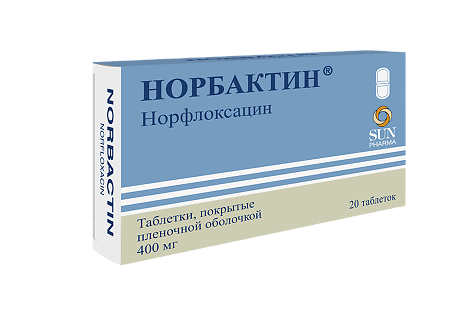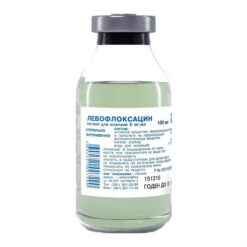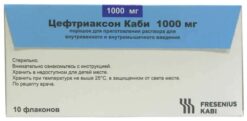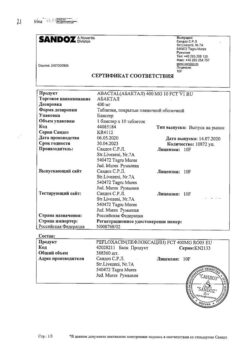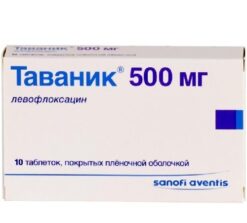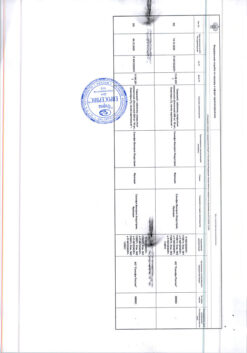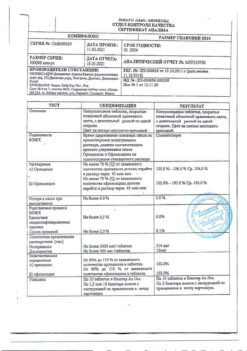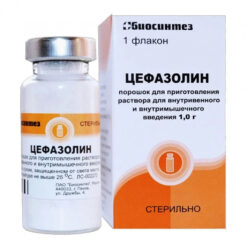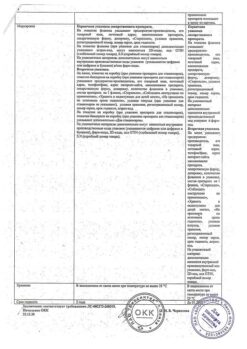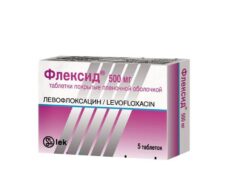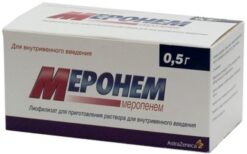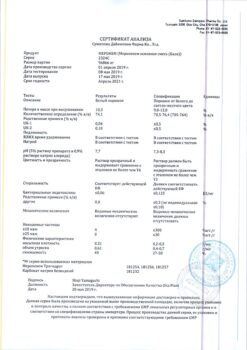No products in the cart.
Norbaktin, 400 mg 20 pcs
€16.59 €13.83
Description
Pharmacological action – broad spectrum antibacterial (bactericidal).
Pharmacodynamics
An antibacterial agent of the group of fluoroquinolones. It has a bactericidal effect. It affects the bacterial enzyme DNA-gyrase, which provides superspiralization and thus the stability of bacterial DNA. Destabilization of DNA chain leads to the death of bacteria. It has a broad spectrum of antibacterial action.
Sensitive: Staphylococcus aureus (including strains of Staphylococcus spp. resistant to methicillin), Staphylococcus epidermidis, Neisseria gonorrhoeae, Neisseria meningitis, Escherichia coli, Citrobacter spp., Klebsiella spp., Enterobacter spp, Hafnia, Proteus spp. (indole-positive and indole-negative), Salmonella spp., Shigella spp., Yersinis enterocolitica, Campilobacter jejuni, Aeromonas plesiomonas, Vibrio cholerae, Vibrio parahaemolyticus, Haemophilus influenzae, Chlamydia spp., Legionella spp.
Different sensitivity to the drug has: Enterococcus faecalis, Streptococcus spp. (pyogenes, pneumoniae and viridans), Serratio marcescens, Pseudomonas aeruginosa, Acinetobacter, Mycoplasma hominis, Mycoplasma pneumoniae, Mycobacterium tuberculosis, Mycobacterium fortuim.
Intolerant: Ureaplasma urealyticum, Nocardia asteroides, anaerobic bacteria (e.g. Bacteroides spp.,, Peptococcus spp., Peptostreptococcus spp., Eubacterium spp., Fusobacterium spp., Clostridium difficile), Treponema pallidum. Duration of effect – about 12 hours.
Pharmacokinetics
Absorption – 20-40% (food slows down). Tmax in plasma – 1 h. Binding to plasma proteins – 10-15%. Well distributed in the body (renal parenchyma, ovaries, seminal tubules fluid, prostate, uterus, abdominal and pelvic organs, bile, mother’s milk). It penetrates through the BBB and the placenta. It is metabolized in liver to a small extent.
Extracted by the kidneys through glomerular filtration and tubular secretion. Within 24 hours after the dose 32% of it is excreted unchanged by kidneys, 5-8% – as metabolites; about 30% of dose taken is excreted in bile.
Indications
Indications
Treatment of infectious and inflammatory diseases caused by sensitive microorganisms, including:
– urinary tract infections;
– genital infections;
– uncomplicated gonorrhea;
– gastrointestinal infections;
– prevention of sepsis in patients with neutropenia;
– traveler’s diarrhea.
Pharmacological effect
Pharmacological effect
Pharmacological action – broad spectrum antibacterial (bactericidal).
Pharmacodynamics
Antibacterial agent from the group of fluoroquinolones. Has a bactericidal effect. It affects the bacterial enzyme DNA gyrase, which ensures supercoiling and, thus, stability of bacterial DNA. Destabilization of the DNA chain leads to the death of bacteria. Has a wide spectrum of antibacterial action.
Sensitive: Staphylococcus aureus (including methicillin-resistant strains of Staphylococcus spp.), Staphylococcus epidermidis, Neisseria gonorrhoeae, Neisseria meningitis, Escherichia coli, Citrobacter spp., Klebsiella spp., Enterobacter spp., Hafnia, Proteus spp. (indole-positive and indole-negative), Salmonella spp., Shigella spp., Yersinis enterocolitica, Campilobacter jejuni, Aeromonas plesiomonas, Vibrio cholerae, Vibrio parahaemolyticus, Haemophilus influenzae, Chlamydia spp., Legionella spp.
The following have different sensitivity to the drug: Enterococcus faecalis, Streptococcus spp. (pyogenes, pneumoniae and viridans), Serratio marcescens, Pseudomonas aeruginosa, Acinetobacter, Mycoplasma hominis, Mycoplasma pneumoniae, Mycobacterium tuberculosis, Mycobacterium fortuim.
Insensitive: Ureaplasma urealyticum, Nocardia asteroides, anaerobic bacteria (for example, Bacteroides spp., Peptococcus spp., Peptostreptococcus spp., Eubacterium spp., Fusobacterium spp., Clostridium difficile), Treponema pallidum. The duration of the effect is about 12 hours.
Pharmacokinetics
Absorption – 20–40% (food slows down). Tmax in plasma – 1 hour. Plasma protein binding – 10-15%. Well distributed in the body (kidney parenchyma, ovaries, seminiferous tubule fluid, prostate gland, uterus, abdominal and pelvic organs, bile, breast milk). Penetrates through the blood-brain barrier and the placenta. Metabolized to a small extent in the liver.
It is excreted by the kidneys, by glomerular filtration and tubular secretion. Within 24 hours of administration, 32% of the dose is excreted unchanged by the kidneys, 5–8% in the form of metabolites; About 30% of the dose taken is excreted with bile.
Special instructions
Special instructions
If it is necessary to prescribe Norbactin® during lactation, the issue of stopping breastfeeding should be decided.
During treatment with the drug, patients should receive a sufficient amount of fluid (under the control of diuresis).
During therapy with norfloxacin, an increase in the prothrombin index was noted.
When performing surgical interventions, the state of the blood coagulation system should be monitored.
During treatment with Norbactin®, exposure to direct sunlight should be avoided.
If pain appears in the tendons or at the first signs of tenosynovitis, it is recommended to discontinue the drug.
Influence on the ability to drive vehicles and operate machinery. Due to the possible occurrence of dizziness, patients taking Norbactin® should be careful when driving a car and engaging in other potentially hazardous activities that require increased attention and speed of psychomotor reactions (especially when consuming alcohol at the same time).
Active ingredient
Active ingredient
Norfloxacin
Composition
Composition
1 Film-coated tablet:
Active substance:
norfloxacin – 400.00 mg,
excipients: MCC; croscarmellose sodium; sodium lauryl sulfate; corn starch; colloidal silicon dioxide; magnesium stearate; purified talc,
shell: hypromellose; macrogol 400; purified talc; titanium dioxide; purified water (lost during the production process).
Contraindications
Contraindications
– hypersensitivity to norfloxacin or other drugs from the fluoroquinolone group;
– deficiency of glucose-6-phosphate dehydrogenase;
– atherosclerosis of cerebral vessels;
– cerebrovascular accident;
– epilepsy, convulsive syndrome;
– renal/liver failure;
– pregnancy;
– lactation period;
– childhood and adolescence (up to 18 years).
Side Effects
Side Effects
From the digestive system: anorexia, bitterness in the mouth, nausea, vomiting, abdominal pain, diarrhea, pseudomembranous enterocolitis (with long-term use), increased activity of liver transaminases.
From the urinary system: crystalluria, glomerulonephritis, dysuria, polyuria, albuminuria, urethral bleeding, hypercreatininemia.
From the nervous system: headache, dizziness, insomnia, hallucinations.
From the cardiovascular system: tachycardia, arrhythmias, decreased blood pressure, fainting, vasculitis.
Allergic reactions: skin itching, urticaria, swelling, Stevens-Johnson syndrome.
From the musculoskeletal system: arthralgia, tendinitis, tendon ruptures.
From the hematopoietic organs: leukopenia, eosinophilia, decreased hematocrit.
Other: candidiasis.
Interaction
Interaction
Simultaneous use of antacids containing aluminum or magnesium hydroxide, as well as drugs containing iron, zinc, sucralfate reduces the absorption of norfloxacin (the interval between their administration should be at least 4 hours).
Reduces the clearance of theophylline by 25%, therefore, with simultaneous use, the dose of theophylline should be reduced.
The simultaneous administration of norfloxacin with drugs that have the potential to lower blood pressure can cause a sharp decrease in blood pressure. In this regard, in such cases, as well as with the simultaneous administration of barbiturate-containing anesthetics, heart rate, blood pressure, and ECG indicators should be monitored.
Concomitant use with drugs that lower the seizure threshold can lead to the development of epileptiform seizures.
Increases the concentration of indirect anticoagulants, cyclosporine (mutually) in the blood serum.
Reduces the effect of nitrofurans.
Overdose
Overdose
Symptoms (3 g in 45 minutes): dizziness, nausea, vomiting, drowsiness, cold sweat, puffy face without changes in basic hemodynamic parameters.
Treatment: gastric lavage, adequate hydration therapy with forced diuresis. Requires examination and observation in a hospital for several days.
There is no specific antidote.
Storage conditions
Storage conditions
In a dry place, at a temperature not exceeding 25 °C.
Keep out of the reach of children.
Shelf life
Shelf life
3 years. Do not use after the expiration date stated on the package.
Manufacturer
Manufacturer
Sun Pharmaceutical Industries Ltd, India
Additional information
| Shelf life | 3 years. Do not use after the expiration date stated on the package. |
|---|---|
| Conditions of storage | In a dry place at a temperature no higher than 25 ° C. Keep out of reach of children. |
| Manufacturer | Sun Pharmaceutical Industries Ltd, India |
| Medication form | pills |
| Brand | Sun Pharmaceutical Industries Ltd |
Related products
Buy Norbaktin, 400 mg 20 pcs with delivery to USA, UK, Europe and over 120 other countries.

